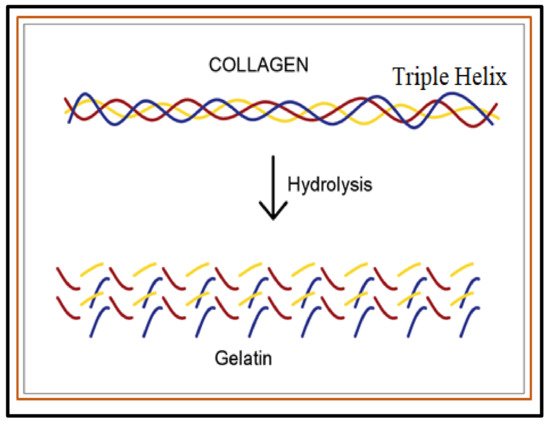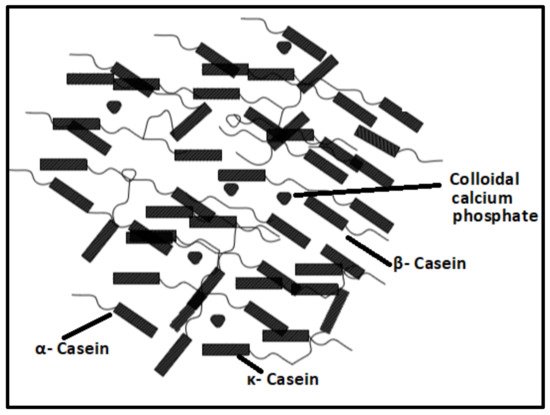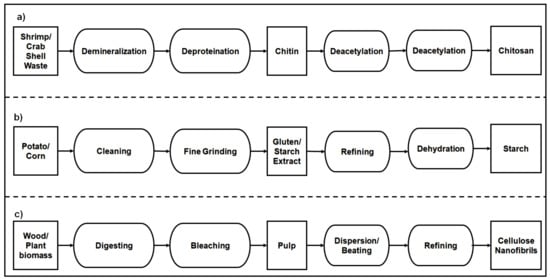1. Introduction
Natural polymers are abundantly available in many renewable resources. At present, biomass resources are mainly utilized for the production of various food products, oil, feed grains, bioenergy, and cosmetic products. The production and utilization details of various resources used for the manufacture of natural polymers in the U.S.A. are presented in Table 1.
Table 1.
Renewable resources and their production volume in the U.S.A. during the year 2017.
12.
Casein polymer structure.
Collagen is the most abundant (about 25%) protein which is present in the cell walls of vertebrates and invertebrates
[19][20][53,54]. Gelatin proteins are extracted from collagen by acetic acid hydrolysis (
Figure 23). It exhibits good solubility in water. The gelatin proteins are a mixture of long and short amino acids connected by peptide bonds. The amino acid sequences determine the polymer structure and the properties of protein polymer
[21][55]. Gelatin-based edible films and coatings were developed to use in food packaging. A gelatin polymer from fish skin was extracted with an acid-and-base treatment
[22][56]. The improvement in the physical and mechanical properties of gelatin-based films was observed with the addition of antimicrobial, antioxidant, and lipid agents. The gelatin films and coatings were produced by dip coating, casting, and extruding
[23][57].
Figure 23.
A change in collagen polymer structure during hydrolysis.
Sericin is a protein extracted from silk fibers by a degumming process using boiled water. Sericin has different amino acids such as serine, glycine, glutamate, and threonine
[24][58]. The carboxyl, amino, and hydroxyl groups are the major polar groups present in this protein. These polar groups are reactive elements that enable crosslinking between molecular chains. As the standalone film-forming characteristics of sericin are not good, it is used with other polymers to make packaging film and coatings
[25][26][59,60].
The animal proteins have good film-forming abilities, with poor tensile and water vapor barrier properties. Crosslinking and plasticizers were used to increase the tensile strength of the films. They were found suitable for edible coating and films. The water vapor transmission was increased by 100% with increased pore size by crosslinking
[27][61]. The mechanical and barrier properties of animal protein-based natural polymers are presented in
Table 2.
Table 2.
Tensile and barrier properties of animal protein films.
a TS—Tensile strength. b YM—Young’s modulus. c ASTM test for water vapor permeability—E96-95. d ASTM test for tensile strength—D882. e ASTM test for tensile strength—D1708-93. f Casein in NaOH/H2O solution and Heat treated at 130 °C/18 h. g Casein in 3-aminopropyl triethoxy silane solution—Heat treated at 130 °C/18 h. h Casein in NaOH/H2O solution- Air dried. i Casein in NaOH/H2O solution—Heat treated at 130 °C/18 h. j Casein in 3-aminopropyl triethoxy silane solution- Heat treated at 130 °C/18 h. k Casein in 3-aminopropyl triethoxy silane solution- Air dried. l Gelatin solution without pH modification. m Gelatin solution with HCl acid modified pH (2.0). n Gelatin solution with NaOH base modified pH (10.0).
2.2. Protein-Based Natural Polymers from Plant Resources
Wheat grains have starch, lipids, and gluten proteins. The gluten proteins are constituted with high contents of gliadins and glutenin bonded by disulfide, hydrogen, and ionic and hydrophobic bonds. These proteins are especially characterized by their protein molecular weights and are extracted from wheat by treatment with ethanol
[31][32][65,66]. Gluten-based films for packaging applications were developed with plasticizers such as glycerol and sorbitol for the improvement of tensile properties. The tensile strength of gluten-based films is less than that of polyethylene-based materials, although the percentage of elongation is comparable with polyethylene-based materials
[33][34][67,68].
Soy protein isolate (SPI), which contains 92%, protein, is extracted from soybean by removing fats, carbohydrates, fibers, and moisture. The SPI is a mixture of albumins and globulins proteins with many functional groups such as carboxyl, amine, and hydroxyls. SPI is extracted from de-fatted soy flakes by treating with either water or mild alkali (pH 7–9) at 50–55 °C and precipitated by adjusting the pH to ∼4.5 with food-grade acid
[35][69]. The tensile properties of SPI materials were modified with plasticizer and formed into films by casting or melt processing.
Zein protein is extracted from corn by treating it with aqueous ethanol extract and a dry milling process. It contains mostly α-zein, which can self-assemble into a microstructure to form a film or coating
[36][37][38][70,71,72]. The films formed with native zein proteins are brittle and sensitive to high relative humidity.
The plant-based protein natural polymers exhibited excellent film-forming abilities. Their brittle nature and poor resistance to moisture absorbance are the limiting factors that prevent them from being considered for packaging applications. The summary of mechanical and barrier properties of plant protein-based natural polymers is listed in Table 3.
Table 3.
Tensile and barrier properties of plant protein films.
Renewable
Resources |
Natural Polymer Type and Compositions |
Production
Volume
(Million
Metric Tons) |
Current Use |
Reference |
| Milk |
Contains 33 g of protein/L. 80% casein and 20% whey protein |
97.76 |
Used as a fat substitute. Butter, dry skim milk, cheese, whey, whey protein concentrate, and lactose are produced from milk. |
[1][2][35,36] |
| Pork & Beef |
More than 29% gelatin is available in pig skin. In beef meat, 10.6~21.9% of gelatin protein available in rib and shank |
11.91 |
Used as meat. By-products such as skin, bones, and connective tissues are used to produce gelatin |
[2][3][36,37] |
| Wheat |
Contains 76.5% starch |
47.38 |
Used for the production of food products |
[2][4][36,38] |
| Soybeans |
Contains 31.7 to 58.9% protein |
120.07 |
Source for animal protein and vegetable oil |
[2][5][36,39] |
| Corn grain |
Contains about 70–72% starch |
371.10 |
Source for corn meal, starch, oil, bioethanol, syrup, sugar, and feed grain |
[2][6][36,40] |
| Potato |
Contains 20% of potato dry matter with 60–80% of starch |
22.91 |
Source for food products and starch |
[2][7][36,41] |
| Crustaceans (Shrimp and Crab) |
Crab shell contains 9.6% chitin and shrimp shell contains 4% chitin |
0.32 |
Source for seafood and compost |
[8][42[9],43] |
| Forestry biomass resources |
40~50% cellulose |
139.71 |
Biofuels, wood products such as timber, lumber, etc. |
[10][11][44,45] |
| Agricultural biomass resources |
25~40% cellulose |
130.64 |
Source for bioenergy, biofuels, and bioproducts |
[10][11][44,45] |
| Waste (Agricultural wastes, forestry wastes) |
25~50% cellulose |
61.69 |
Source for compost, bioenergy |
[10][11][44,45] |
2. Protein-Based Natural Polymers
2.1. Proteins-Based Natural Polymers from an Animal Resource
Milk is a colloidal solution constituted of fat, minerals, vitamins, and a heterogeneous mixture of the proteins casein (80%) and whey (20%). Flexible and transparent films were produced from casein and whey proteins present in the milk. The whey proteins are the aggregate of soluble globular proteins in serum albumin
[12][46]. The casein proteins contain four forms of protein, namely, α
s1, α
s2, β, and κ casein (
Figure 12)
[13][47]. The whey and casein proteins are polymerized from milk by acidification and heat treatment processes and are separated by micro- and ultra-filtration techniques
[14][15][48,49]. The protein molecules tend to form films due to bonding and electrostatic interaction. The film and coating properties of casein are determined from the calcium micelles formed by the hydrophobic and electrostatic interactions of protein molecules and calcium bridging elements
[16][50]. As the native milk protein films are brittle, plasticizers were added to weaken the bonding between protein chains. The crosslinking agents and plasticizers enhanced the mechanical and physical properties of the films
[17][18][51,52].
a TS—Tensile strength. b YM—Young’s Modulus. c Films conditioned in a chamber at 23 °C and 50% RH for at least 48 h. d ASTM test method for Water vapor permeability—E96-95.
3. Polysaccharide-Based Natural Polymers
3.1. Polysaccharide-Based Natural Polymers from an Animal Resource
Chitin is a polysaccharide extracted from crab and shrimp shells by demineralization and deproteination processes as shown in
Figure 34a. The monosaccharide units of chitin have an acetyl amine group (-CH
3-CO-NH) and are linked by β-(1 → 4) covalent bonds
[42][76]. The acetyl amine group present in the chitin causes strong hydrogen bonding between adjacent polymers. The antibacterial and antifungal properties and abundant availability of chitin attracted food packaging applications
[43][44][45][77,78,79]. The tensile strength of around 18 MPa and the percentage of elongation of 6% were achievable for films manufactured from chitin natural polymer by film casting
[46][80].
Figure 34.
The production of polysaccharide natural polymers (
a
) Chitosan (
b
) Starch (
c
) Cellulose Nanofibrils (CNF).
Chitosan is the natural polymer manufactured from chitin by deacetylation with base agents as shown in
Figure 34a. They are available in a different range of molecular weights and degrees of deacetylation. The primary functional groups available in these polymers are hydroxyl (OH), amine (NH
2), and ether (C-O-C)
[47][81]. The presence of amino groups makes chitosan a positively charged polysaccharide. Chitosan is not soluble in water but is soluble in weak acidic solutions. To develop chitosan as packaging materials, hydrophilic properties attributed to hydroxyl groups were improved by crosslinking, and the elongation at break was improved by blending with plasticizer
[48][82]. The tensile strength and percentage of elongation at the break of the chitosan films modified by citric acid crosslinking were around 13 and 48 MPa, respectively
[49][83].
3.2. Polysaccharide-Based Natural Polymers from Plant Resource
Thermoplastic starch (TPS) is a polysaccharide polymer that is extracted from biomass such as corn, wheat, rice, potato, cassava root, barley, and oat as shown in
Figure 34b. The structure of TPS is constituted of amylose and amylopectin macromolecules
[50][84]. The tensile strength and percentage of elongation of native starch are 5 and 50 MPa, respectively
[51][85]. Thermoplastic starch plasticized by polyols was investigated to use as an edible coating and packaging film. Tensile strengths of 10 to 30 MPa and percentages of elongation at break of 3 to 60% were obtained with 20 to 30% glycerol as a plasticizer in packaging film production with starch biopolymers
[52][53][86,87].
Cellulose is an extract from plants and is the most abundant material on earth. It forms a polymeric structure with β-D-glucopyranose units having reactive hydroxyl groups in C2, C3, and C6 and linked by a covalent bond with acetal groups in C4 and C1
[54][88]. They are widely extracted from wood and plant biomass resources as shown in
Figure 34c. The adjacent cellulose molecules form hydrogen bonds and make rigid structures during the film-forming process. The films with microcellulose fibrils showed 80 MPa tensile strength
[55][89]. The nanocellulose films manufactured from different resources and different extraction processes exhibited distinct tensile properties. The softwood nanocellulose films manufactured by the tempo oxidation method had a tensile strength of 82 MPa and percentage elongation at a break of 1
[56][90].
4. Lipid-Based Natural Polymers
Wax-based natural polymers are used as edible films and coating
[57][91]. The wax polymers constitute majorly long chain hydrocarbons and esters. They are insoluble in water but soluble in organic solvents. The temperature dependence of wax-based film is a limiting factor in using these films in packaging applications
[58][92]. Similarly, the use of lacquers in packaging applications is limited to coatings on metallic surfaces to avoid harmful elements in packaging materials
[59][60][61][93,94,95]. The hydroxyl groups of acetylated fatty acids were modified to enable crosslinking between molecules to increase the tensile strength of the coating. The tensile strength of these films was found to be 1.76 MPa
[62][63][96,97].



